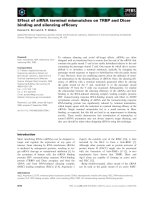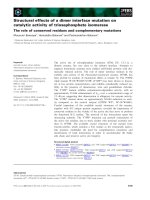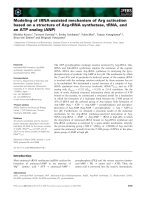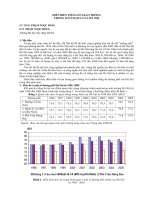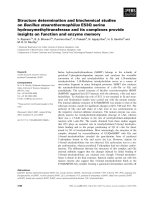Tài liệu Báo cáo khoa học: "REMARKS ON PLURAL ANAPHORA" pptx
Bạn đang xem bản rút gọn của tài liệu. Xem và tải ngay bản đầy đủ của tài liệu tại đây (619.54 KB, 7 trang )
REMARKS ON PLURAL ANAPHORA*
Carola Eschenbach, Christopher Habel, Michael Herweg, Klaus Rehk/imper
Universit~it Hamburg, Fachbereich Informatik, Projekt GAP
Bodenstedtstr. 16
D-2000 Hamburg 50
e-mail: HABEL at DHHLILOG.BITNET
ABSTRACT
The interpretation of plural anaphora
often requires the construction of complex
reference objects (RefOs) out of RefOs
which were formerly introduced not by
plural terms but by a number of singular
terms only. Often, several complex RefOs
can be constructed, but only one of them is
the preferred referent for the plural anaphor
in question. As a means of explanation for
preferred and non-preferred interpretations
of plural anaphora, the concept of a Com-
mon Association Basis (CAB) for the
potential atomic parts of a complex object is
introduced in the following. CABs pose
conceptual constraints on the formation of
complex RefOs in general. We argue that in
cases where a suitable CAB for the atomic
RefOs introduced in the text exists, the cor-
responding complex RefO is constructed as
early as in the course of processing the ante-
cedent sentence and put into the focus
domain of the discourse model. Thus, the
search for a referent for a plural anaphor is
constrained to a limited domain of RefOs
according to the general principles of focus
theory in NLP. Further principles of inter-
pretation are suggested which guide the
resolution of plural anaphora in cases where
more than one suitable complex RefO is in
focus.
* The research on this paper was
supported in part by the Deutsche
Forschungsgemeinschaft (DFG) under grant
Ha 1237/2-1. GAP is the acronym for
"Gruppierungs- und Abgrenzungsgrozesse
beim Aufbau sprachlich angeregter mentaler
Modelle" (Processes of grouping and
separation in the construction of mental
models from texts), a research project
carried out in the DFG-program "Kognitive
Linguistik".
1.
INTRODUCTION
Most approaches to processing anaphora
concern themselves mainly with the case of
singulars and deal only peripherally with the
complications of plurals. An analysis of
plural anaphora should answer the following
additional questions:
1) How are the referents of plural terms
represented by discourse entities (internal
proxies)?
2) How is the link between plural anaphora
and suitable antecedent discourse entities
established?
3) How are complex discourse entities con-
structed from atomic ones?
4) When are complex discourse entities
constructed in the process of text com-
prehension?
The present paper addresses primarily the
third and fourth questions. However, we
will give some sketchy answers to the first
and second questions as well.
We consider only two-sentence texts in
which the second sentence contains an
anaphoric pronoun that refers to entities
introduced in the first sentence by various
constructions:
(1) a. The children were at the cinema.
They had a great time.
b. Michael and Maria were at the cinema.
They had a great time.
c. Michael was at the cinema with Maria.
They had a great time.
d. Michael met Maria at the cinema.
They had a great time.
The question is: To which entities, i.e.
complex discourse entities, does the plural
anaphor th_h~ refer? Surely in (1.a) to the one
corresponding to the children, and in (1.b),
(1.c) and (1.d) to Michael and Maria. Up to
now, most analyses of plural anaphora
- 161-
investigate cases of the (1.a)- or (1.b)-type,
i.e. those in which the complex object is in-
troduced explicitly, either by a simple plural
NP or by a conjunction of singular or plural
NPs (which in both cases yields a plural NP
as well).
2. A SKETCH ON PLURALITY
We assume -as is common in most
recent approaches to anaphora in AI and
linguistic semantics (e.g. Webber 1979,
Kamp 1984)- a representation level of
discourse referents, which are internal
proxies of objects of the real (or a possible
or fictional) world. These discourse entities,
called reference objects (RefOs), are stored
and processed in a net-like structure, called a
referential net (RefN), which links RefOs
and designations. (For a detailed description
see Habel 1982, 1986a, 1986b and Eschen-
bach 1988.) The term "RefO" is, when
strictly used, a technical notion which is
employed in the framework of our formal-
ism only. For reasons of simplicity of expo-
sition, we do not want to restrict the use of
"RefO" to this formalism in the present
paper, but rather apply the term to referents
also, i.e. the objects to which names,
descriptions and pronouns refer.
RefOs for complex objects are con-
structed by means of a sum operation (Link
1983), so that with respect to (1.b), we have
the following entries (among others) in the
RefN.
rl Michael
r2 Maria
r3 = rl • r2
The sum operation (symbolized by ~) is
the semantic counterpart of the NP-connec-
tive and. It defines a semi-lattice (Link 1983,
Eschenbach 1988). By means of this struc-
ture, both complex and atomic RefOs can be
seen as objects of the same logical type and
are accessible by the same set of referential
processes. No operations on RefOs other
than the sum operation will be considered in
the present context.
3. CONSTRAINTS ON SUM FOR-
MATION
Sentences like (1.a) and (1.b) demon-
strate that complex discourse referents can
be created by plural NPs. But there are other
linguistic indicators for the creation of com-
plex RefOs.1 The anaphoric pronoun they of
(1.c) and (1.d) as well as (1.b) refers to a
corresponding complex RefO. It is obvious
that besides conjunctions (e.g. and), some
prepositions and verbs trigger processes of
sum formation (with-PPs and meet are out-
standing examples of these types of con-
structions.) In (1.c), Michael with Maria
triggers the formation of Michael ~ Mafia.
But consider the following texts:
(2) a. Michael and Mafia were at the park
with Peter.
In the evening they were at a garden
party.
b. Michael and Mafia were at the park
with their frisbee.
In the evening they were at a garden
party.
In (2.a) it is possible that they refers to
Michael ~ Maria ~ Peter. But in (2.b) they
is preferably linked to Michael ~ Maria;
even if Michael and Mafia happened to take
their frisbee to the garden party, we would
not want to claim that the plural anaphor they
in (2.b) refers to a complex discourse entity
consisting of Michael, Mafia and the frisbee.
In the preferred reading 6f (2.b), the frisbee
is excluded from the antecedent of the
anaphor.
We have to explain why with-PPs only
cause sum formation in certain cases. The
proposed solution to this problem is the
concept of a Common Association Basis
(CAB), which is introduced in Herweg
(1988). The CAB is an extension of the
Common Integrator (CI), which Lang
(1984) developed in his general theory of
coordinate conjunction structures.
1
The assumption of indicators and
constraints contrasts to the less restrictive
assumption of Frey & Kamp's (1986) DRT-
oriented analysis of plural anaphora, in
which they claim that "any collection of
available reference markers, whether
singular or plural, can be 'joined together' to
yield the antecedent with which the pronoun
can be connected" (p. 18).
- 162 -
Grouping by with depends on the condi-
tion that "x with y" leads to "x ~ y" only in
those cases in which a CAB-relation is ful-
filled. The most relevant constraint given by
CAB is the condition that x and y are
instances of the same ontological type at the
most fine-grained level. This means two
humans are good candidates to form a com-
plex RefO, whereas a frisbee, which does
not fall under the ontological type of humans
or animate objects, and the human players
are not.
CAB constraints apply not only to cases
like (1.c) and (2.b), but to sum formation in
general. Consider this example:
(3) Michael and his frisbee were at the
park.
Here the conjunction explicitly forces the
sum formation of objects of different onto-
logical types. This is at least unusual and has
a strange effect. However, explicit conjunc-
tion by ~nd presupposes the existence of a
suitable CAB for the conjoined entities. The
addressee must assume that the conjunction
in (3) involves an instruction to derive such
a CAB (or simply concede that one exists).
Thus, to make conjunctions like the one in
(3) acceptable and natural, one normally has
to assume a CAB which is not explicitly
specified or immedeatly derivable from the
information conveyed in the sentence itself
but which is given by the preceding or extra-
linguistic context. In (3), the required CAB
might simply be something like 'the entities
desperately being looked for by Michael's
children'. In isolation however, forced sum
formations like the one in (3) must be con-
sidered marginally acceptable.
We now have the following situation:
Grouping depends on properties of the
RefOs in question, namely whether a CAB
exists which constitutes a conceptual relation
among the RefOs with respect to situational
parameters given, for example, by predica-
tive concepts. Furthermore, it is obvious that
world knowledge and the theme of the
discourse give evidence for which (complex)
RefO is most appropriate as the antecedent
of an anaphoric pronoun. We will propose
that these factors can be handled by CABs as
well.
This leads us to Herweg's (1988) Princi-
ple of Connectedness:
All sub-RefOs of a complex RefO must
be related by a CAB.
Now consider example (1.d). It shows
that some lexical concepts possess what we
call grouping force, i.e. they trigger sum
formation with respect to atomic RefOs. The
grouping force of a lexical concept can be
seen as a special case of a CAB. Without
going into details of the representation
formalism we can formulate the relevant sum
formation processes by this rule:
If "x meets y", then construct the com-
plex RefO x ~ y.
The status of this sum formation rule is
similar to that of classical inference rules,
which are used for bridging processes in the
sense of Clark (1975). Not all verbs possess
a grouping force as strong as meet; e.g. the
grouping force of watch is considerably
lower. Consider:
(4) a. Michael met Peter and Maria in the
pub. They had a great time.
b. Michael watched Peter and Maria in
the pub. They had a great time.
In (4.b), the sum of Maria and Peter is
significantly preferred to the sum including
Michael as the antecedent of they. In (4.a),
there presumably is a preference to the
opposite, i.e. to link they to the sum con-
sisting of all three persons. In contrast to
highly associative verbal concepts like meet,
watch must be classified as a dissociative
element which does not constitute a CAB for
its arguments but induces a conceptual sepa-
ration. Part of the explanation for this prop-
erty of watch is to be seen in the (normally
understood) local separation of subject and
object in the situation described. Again in
contrast to meet, this local separation usually
prevents an interaction or some other kind of
contact which allows one to assume a suit-
able link (i.e. a CAB) for the persons intro-
duced based on properties of the situation
which the sentence describes.
4.
ANAPHORA RESOLUTION AS
A SEARCH PROCESS?
Many classical approaches to anaphora
resolution are based on search processes.
- 163 -
Given an anaphor, a set of explicitly intro-
duced referents is searched for the best
choice. 2 The crucial point is: "How to deter-
mine the set of possible antecedents?"
The most simple solution is the history
list "of all referents mentioned in the last
several sentences" (Allen 1987, p. 343).
Note that most DRT-based anaphora resolu-
tion processes (Kamp 1984, Frey & Kamp
1986) by and large follow this line, with a
few modifications concerning structural
conditions in terms of an accessibility rela-
tion.
But there is also a different perspective
whose key notion is the well-established
concept of focus (see e.g. in Computational
Linguistics Grosz & Sidner 1986) 3. As is
shown by psychological experiments (an
detailed overview is given by Guindon
1985), a very limited number of discourse
referents are focussed. Referents in the
focus, which can be described in psycho-
logical terms as short term memory (see
Guindon), are quickly accessed; especially
pronouns are normally used to refer to items
in the focus and therefore extensive search is
mostly unnecessary. The most relevant
question with respect to focus is "Which
items are currently in the focus? ''4. Answers
2 Note that the unspecifity of pronouns
seldom allows the triggering of bridging
inferences (see Clark 1975) to select
referents which are only implicitly
introduced.
3 Cf. Bosch (1987) and Allen (1987;
chap. 14). Both give convincing arguments
against the simplistic view of identifying
anaphora resolution with searching. Since
we address matters of pronominal anaphora
only, we here assume a rather simple
concept of focus. Further differentiations
(e.g. Garrod & Sanford's (1982) division of
focus into an explicit and implicit
component) which might become necessary
if non-pronominal anaphora are investigated
as well are out of the scope of the present
paper.
4 A question closely related to this,
namely at which point of time and in what
to this question determine which referents
can be antecedents of pronouns.
5. PLURALS IN FOCUS
Following the line of argumentation in
section 4, the possibility of a reference to a
complex RefO with a plural pronoun as in
(1) means that such a complex RefO is in the
focus after processing the first sentence.
Thus it is worth taking a closer look at the
question as to when a complex RefO is
formed. There are essentially two opportu-
nities to construct a complex RefO from
atomic RefOs: it can be constructed and put
into the focus when the atomic RefOs are
mentioned, or the construction might be
suspended until an anaphor triggers the sum
formation. 5 The second solution has some
undesirable consequences; the worst is that
the methods of resolving plural anaphora
and singular anaphora must be completely
different. Since the complex RefOs would
not be in the focus, a direct access to the
focussed entities could not solve the prob-
lem. In such cases, the construction process
would be triggered during anaphora resolu-
tion. Thus the processing of they with
respect to Michael ( ) with Maria in (1.c)
and Michael met Maria in (1.d) should be
more complicated than the cases of the
children or Michael and Maria, an assump-
tion for which no evidence exists as yet.
Therefore, we take the former choice of
constructing the complex RefO while pro-
cessing the atomic RefOs. Again, this sug-
gests two possibilities, namely to construct
the complex RefO and put only this into the
focus, or to introduce both the complex and
the atomic RefOs into the focus. As a
working hypothesis, we propose the latter
procedure, since the sentences like (5),
way the focus is updated, is not relevant as
long as we confine ourselves to texts
containing only two sentences. However, it
becomes important when the analysis is
expanded to multiple sentence texts.
5 This distinction corresponds to
Charniak's (1976; p. 11) well-known
dichotomy of read-time and question-time
inferences.
- 164-
which contain singular anaphora (cf. (1)),
are fully coherent:
(5) a. Michael and Mafia were at the cinema.
He/She had a great time.
b. Maria was at the cinema with Michael.
He/She had a great time.
c. Michael met Mafia at the cinema.
He/She had a great time.
That these findings do not depend on
linguistic introspection only is established by
processing-time experiments, which are
reported in Mtisseler & Rickheit (1989). 6
The initial results of the experiments suggest
that the complexities of processing singular
or plural anaphora (of sentences like (1) vs.
(5) are not significantly different 7. The
anaphoric accessibility of the complex RefOs
which are introduced by the sentences listed
above is by no means worse than the acces-
sibilty of the atomic RefOs.
Let us summarize the discussion so far:
There are linguistic concepts -such as
conjunctions, prepositions and lexical con-
cepts- which trigger the construction of
complex RefOs. The atomic RefOs as well
as the complex RefO (which is formed by
6 Mtisseler's and Rickheit's research at
the University of Bielefeld is also carded out
in a project in the DFG-Program "Kognitive
Linguistik". This project collaborates with
ours on reference phenomena from
computational and psycholinguistic points of
view.
7 This holds at least for cases where the
antecedent of the singular anaphor is in
subject/topic position. Questions concerning
the accessibility of singular antecedents in
non-subject/non-topic positions are not
definitely settled as yet (see Mtisseler &
Rickheit 1989). Since Mtisseler's and
Rickheit's experiments are confined to
German, which has a single form ~ie for 3rd
pl. pronoun (they) and 3rd sg. fern. pronoun
(she), not all of their results on the
processing-time of singular anaphora with
antecedents in different structural positions
can be applied to English.
the sum operation) are introduced into the
focus. Thus, resolution of anaphora can be
performed by processes on the focus not
involving extensive search.
6. FURTHER PRINCIPLES OF
ANAPHORA RESOLUTION
Further interesting problems can be ob-
served in the interaction of concepts which
possess grouping capacity. Consider:
(6) a. Michael and Maria picked up Peter
and Anne from the station.
They were happy to see each other
again.
b. Michael and Mafia picked up Peter
and Anne from the station.
They were late.
Here the following atomic and complex
RefOs exist:
rl - Michael
r2 - Maria
r3 Peter
r4 Anne
r5 =rl ~r2
r6 = r3 • r4
r7 =r5 • r6 = rl • r2 • r3 ~r4
In the preferred interpretation, they in
(6.a) refers to r7, in (6.b) either to r5 or r6. It
follows from this analysis that more than
one complex RefO can be in focus. Which
one is the most appropriate to link to the
pronoun depends on two principles (see
Herweg 1988):
Principle of Permanence:
It is prohibited (unless the text explicitly
requires it) to link the plural pronoun to a
proper sub-RefO of a complex RefO in
focus. Reference to a sub-RefO is only pos-
sible if it was introduced explicitly into the
discourse model by a previous inference.
Principle of Maximality:
The plural anaphoric pronoun should be
linked to the maximal sum of appropriate
RefOs with respect to a suitable CAB,
unless the text contains explicit evidence to
the contrary.
The interaction of the principles of Con-
nectedness, Permanence and Maximality can
lead to correct and natural anaphora resolu-
tion in (6). For (6.a), maximality and per-
- 165 -
manence require a maximal sum, which is
rT; in (6.b), knowledge about the situations
of picking someone up and being late
excludes r7 (i.e. no CAB can be established
which is simultaneously satisfied by all
atomic parts of r7; therefore, the condition of
connectedness is not fulfilled) and thus gives
evidence for a sub-RefO, namely either r5 or
r6. The principle of Permanence excludes
other combinations of atomic RefOs, such as
rl • r3, r2 • r3, etc. Whether r5 or r6 is
chosen at last can not be decided on the basis
of the above mentioned principles alone.
These examples show that a conflict resolu-
tion strategy is needed, as is not unusual for
such principles.
7. IMPLEMENTATION
The RefN-processes and sum formation
are currently being implemented in Quintus-
PROLOG on a MicroVax workstation. The
present implementation allows one to repre-
sent and create RefOs and (1) their descrip-
tions by way of designators (internal proxies
for names and definite NPs), (2) their de-
scriptions by way of attributes, which spec-
ify properties (sorts) of the represented ob-
jects themselves (not their designations) and
relations between them. E.g. sums are rep-
resented by the use of attributes to RefOs.
The set of RefOs with their descriptions
can be structured, so that different RefNs,
whether or not they are independent from
each other or related by shared RefOs, may
be represented in parallel.
The representation of a sample text within
the formalism is being worked. The transfer
of segments of the text into simple nets is
not being done automatically but by hand.
For each anaphor, a corresponding RefO
is created but specially marked as an ana-
phoric RefO. This is intended to trigger the
automatic resolution of anaphora.
In the near future, it is planned to
-
determine the potential antecedent-refer-
ents for an anaphor out of the set of all
RefOs which are available;
-
define the requirements concerning the
representation of focus; it is planned to
test different formats of representation;
-
structure the nets in order to represent
CABs.
The function of the last two steps men-
tioned is to put further restrictions on the set
of potential antecedent-referents for a given
anaphor.
8. SUMMARY
Compared to the case of singular pro-
nouns, the resolution of anaphoric plural
pronouns requires an additional step of pro-
cessing: the sum formation. It is guided by
various grammatical and lexical evidence,
which is accumulated to form a common
association basis (CAB). The principle of
connectedness controls the sum formation,
by which the restriction to a very limited
number of complex RefOs is possible. The
role of focus with respect to plural anaphora
is similar to the singular case, but poses the
question as to when the sum formation is
carried out in the process of text compre-
hension. The resolution processes of the
singular and plural cases can be made iden-
tical by assuming that, in cases where a
suitable CAB is available, the sum formation
takes place early, i.e. while processing the
antecedent sentence(s). The principles of
Permanence and Maximality are two princi-
ples which are valid especially for plural
anaphora.
The use of CABs and the mentioned
principles of sum formation is a way to
avoid the inadequacies of prior approaches
to plural anaphora, which mostly seem to
follow the motto "Anything goes".
ACKNOWLEDGEMENTS
We thank Ewald Lang, Geoff Simmons
(who also corrected our English) and Andrea
Schopp for stimulating discussions and three
anonymous referees from ACL for their
comments on an earlier version of this
paper.
REFERENCES
Allen, James F. (1987): Natural Lan-
guage Understanding. Benjamin/Cummings:
Menlo Park, Ca.
Bosch, Peter (1987): Representation and
Accessibility of Discourse Referents. IBM
Stuttgart. (Lilog Report No. 24)
- 166-
Charniak, Eugene (1976): Inference and
Knowledge, part 1. in: E. Charniak &
Y. Wilks (eds.): Computational Semantics.
North Holland: Amsterdam, 1-21.
Clark, Herbert H. (1975): Bridging. in
P. N.
Johnson-Laird & P. Wason (eds.):
Thinking. Cambridge UP: Cambridge, 411-
420.
Eschenbach, Carola (1988): SRL als
Rahmen eines textverarbeitenden Systems.
GAP-Arbeitspapier 3. Univ. Hamburg.
Frey, Werner & Kamp, Hans (1986):
Plural Anaphora and Plural Determiners.
Ms., Univ. Stuttgart.
Garrod, Simon C. & Sanford, Antony J.
(1982): The Mental Representation of Dis-
course in a Focussed Memory System:
Implications for the Interpretation of
Anaphoric Noun Phrases. Journal of Se-
mantics 1, 21-41.
Grosz, Barbara & Sidner, Candace
(1986): Attentions, Intentions, and the
Structure of Discourse. Computational Lin-
guistics 12, 175-204.
Guindon, Raymonde (1985): Anaphora
Resolution: Short-term memory and focus-
ing. 23rd Annual Meeting ACL, 218-227
Habel, Christopher (1982): Referential
Nets with Attributes. in: Proceedings of
COLING-82, 101-106.
Habel, Christopher (1986a): Prinzipien
der Referentialit~it. Springer: Berlin.
Habel, Christopher (1986b): Plurals,
Cardinalities, and Structures of Determina-
tion. in: Proceedings of COLING-86. 62-
64.
Herweg, Michael (1988): Ans~itze zu
einer semantischen und pragmatischen
Theorie der Interpretation pluraler Anaphern.
GAP-Arbeitspapier 2. Univ. Hamburg.
Kamp, Hans (1984): A Theory of Truth
and Semantic Interpretation. in: Groenen-
dijk, J. et al. (eds.): Truth, Interpretation
and Information. Dordrecht: Foris, 1-41
(GRASS 2).
Lang, Ewald (1984): The Semantics of
Coordination. John Benjamins: Amsterdam.
Link, Godehard (1983): The Logical
Analysis of Plurals and Mass Terms: A
Lattice-theoretical Approach. in: R. B~iuerle
et al. (eds.): Meaning, Use, and Interpreta-
tion of Language. Berlin: de Gruyter, 302-
323.
Mtisseler, Jochen & Rickheit, Gert
(1989): Komplexbildung in der Textverar-
beitung: Die kognitive Aufl6sung pluraler
Pronomen. DFG-Projekt "Inferenzprozesse
beim kognitiven Aufbau sprachlich angereg-
ter mentaler Modelle", KoLiBri-Arbeits-
bericht Nr. 17, Univ. Bielefeld.
Webber, Bonnie L. (1979): A Formal
Approach to Discourse Anaphora. Garland:
New York.
~_~ - 167-


